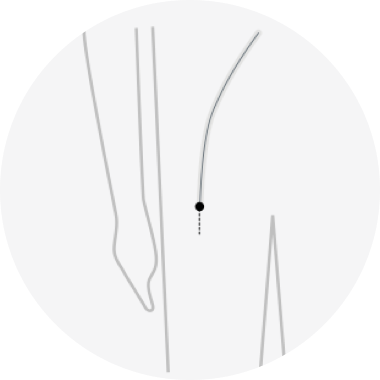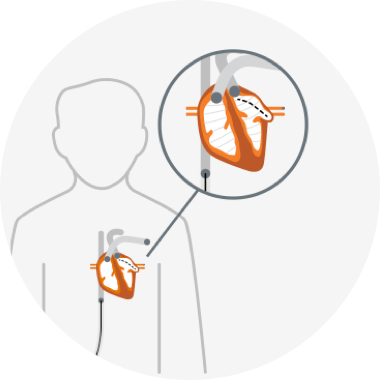The WATCHMAN Implant procedure offers a permanent option to lower stroke risk in people with non-valvular atrial fibrillation (AFib). It’s an alternative to blood thinners for people who need one.
The procedure to get the WATCHMAN Implant is a minimally invasive procedure that uses special techniques that cause less damage and pain compared to traditional surgery. It’s normal to feel a little nervous before any type of AFib medical procedure. In this article, we’ll take you through the WATCHMAN Implant procedure step by step.
What do I do before the WATCHMAN Implant procedure?
A few days or weeks before you get the WATCHMAN Implant, you’ll need testing to measure the size of your left atrial appendage (LAA) and to confirm that you don’t currently have a blood clot. Your doctor can use a computed tomography (CT) scan or a transesophageal echocardiogram (TEE) for this step. Your doctor will recommend the type of testing they believe is best for you.
What happens during the WATCHMAN Implant procedure?
On the day of your WATCHMAN Implant procedure, you’ll arrive at one of the 850 major medical centers certified to implant WATCHMAN.

Your doctor will give you anesthesia medicines before the procedure to make sure you don’t feel any pain. To place the WATCHMAN Implant, your doctor will make a small incision in your upper leg to insert a long narrow tube, or catheter.

Your doctor will guide the WATCHMAN Implant through this tube and into the LAA of your heart. You can watch a video that shows you how the WATCHMAN Implant procedure is done.
WATCHMAN Implant procedure recovery

Most people who get the WATCHMAN Implant stay in the hospital for one day or less. After a few days of recovery, many people can return to work and their normal daily activities. You should pace your return to normal activities gradually as you feel better. However, check with your doctor before you participate in any strenuous activities.
What is recovery like after the WATCHMAN Implant procedure?

Once the WATCHMAN Implant is in place, your own heart tissue will begin to grow over the implant to permanently close the LAA. That’s why this procedure is also called an LAA closure.1 You’ll need a CT scan or TEE to monitor how the heart tissue is growing over the implant 45 days and 1 year after the WATCHMAN Implant procedure.
You’ll need to continue taking blood thinners for a time after the WATCHMAN Implant procedure to allow time for the LAA to completely seal. Most people can stop taking blood thinners 45 days after the procedure.2
Your doctor will prescribe one of two medication regimens:
- In option A, you’ll take a short-term blood thinner for 45 days then switch to taking an antiplatelet drug plus aspirin for 6 months.
- In option B, you’ll take an anti-platelet medication plus aspirin for 6 months.
Ready to leave blood thinners behind? Talk to your doctor about the WATCHMAN Implant.
Already took the quiz? Return to your personalized experience.
References:
- Left Atrial Appendage Closure. Cleveland Clinic website. Updated November 27, 2024. Accessed May 23, 2025. https://my.clevelandclinic.org/health/treatments/17167-left-atrial-appendage--closure
- Kar S, Doshi SK, Sadhu A, et al. Primary Outcome Evaluation of a Next-Generation Left Atrial Appendage Closure Device: Results From the PINNACLE FLX Trial. Circulation. 2021;143(18):1754-1762.
All images are the property of Boston Scientific. All trademarks are the property of their respective owners.
Content on this web page is for Informational Purposes only and does not constitute medical advice and should not be used for medical diagnoses. Boston Scientific strongly recommends that you consult with your physician on all matters pertaining to your health or to address any clinical/medical questions.
Important Safety Information
The WATCHMAN FLX and WATCHMAN FLX Pro Devices are permanent implants designed to close the left atrial appendage in the heart in an effort to reduce the risk of stroke.
With all medical procedures there are risks associated with the implant procedure and the use of the device. The risks include, but are not limited to, accidental puncture of the heart causing fluid to collect around the heart possibly leading towards the need for an additional procedure, allergic reaction, anesthesia risks, altered mental status or confusion after procedure, arrhythmias (irregular heartbeats), bleeding or throat pain from the TEE (Trans Esophageal Echo) probe, chest pain/discomfort, congestive heart failure, renal failure, excessive bleeding, gastrointestinal bleeding, groin puncture bleed, bruising at the catheter insertion site, groin pain, anemia (reduced red blood cells requiring transfusion), hypotension, infection/pneumonia (example: in or around your heart or lungs), misplacement of the device, improper seal of the appendage or movement of device from appendage wall, clot formation on the device, blood clot or air bubbles in the lungs or other organs, stroke, transient ischemic attack (temporary stroke-like symptoms), cranial bleed (bleeding in or around your brain), thrombosis (blockage of a blood vessel or vein by a clot) and in rare cases death can occur.
Be sure to talk with your doctor so that you thoroughly understand all of the risks and benefits associated with the implantation of the device. SH-2109508-AA

